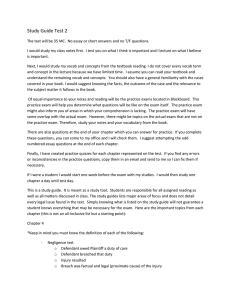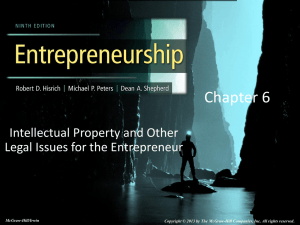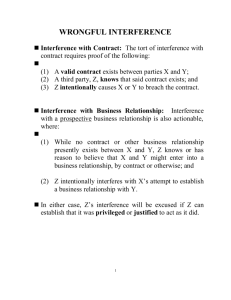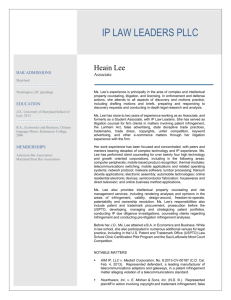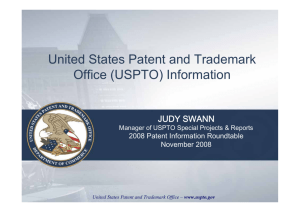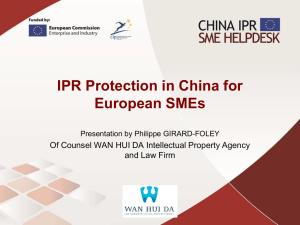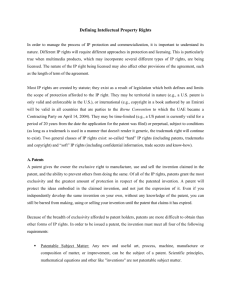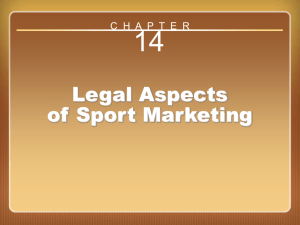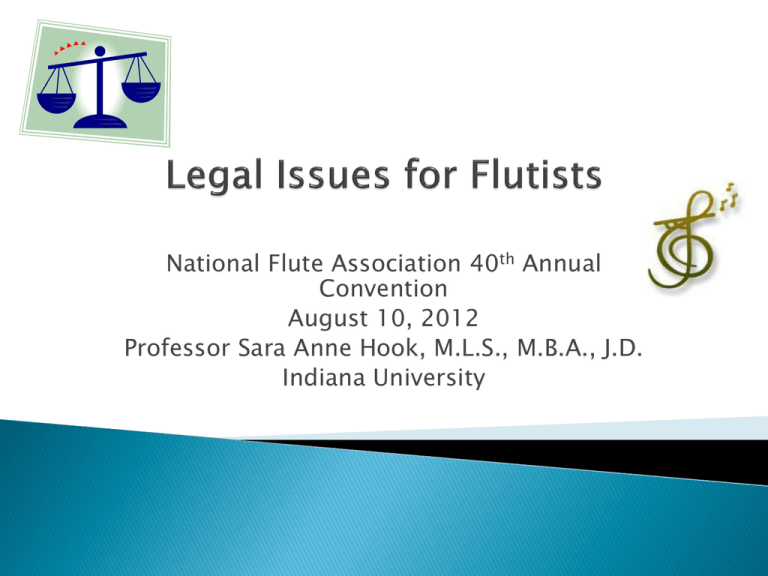
National Flute Association 40th Annual
Convention
August 10, 2012
Professor Sara Anne Hook, M.L.S., M.B.A., J.D.
Indiana University
Intellectual Property (IP) Law
◦ Trademark
◦ Trade Secret
◦ Patent – note America Invents Act (inventions – think
useful)
◦ Copyright (creative work)
Other Related Areas of the Law
◦ Rights of privacy/rights of publicity (social media)
◦ Contracts and licensing
◦ Defamation: libel and slander (social media)
◦ Electronic discovery (social media)
2
Constitution, Article I, Section 8, [8]: To promote the
Progress of Science and useful Arts, by securing for limited
Times to Authors and Inventors the exclusive Right to their
respective Writings and Inventions
Original works of authorship
Fixed in a tangible medium (includes emails, websites, art
work, slides, videos, but not oral communications unless they
are preserved in some fashion)
Minimal amount of creativity
◦ telephone books: Feist v. Rural Telephone case
◦ forms: Baker v. Selden case
◦ databases – unsettled, but compilations (selection,
arrangement)
Expression only, not ideas, data or facts
Not words, names, titles, slogans, phrases (trademark)
3
Copyright law is a federal matter – handled by federal courts –
but there may also be state law claims
Importance of keeping good records – searches to determine
copyright owner, permissions, your own work (to prove
independent creation)
U.S. Copyright Office’s website is very helpful http://www.copyright.gov/ - includes links to copyright law,
forms for registering your creative work, free searchable
database of all copyright registrations , etc.
Many benefits of registration through the U.S. Copyright
Office (statutory damages, attorney fees, presumed the
copyright owner)
◦ Must register in order to sue for copyright infringement – expedited
process is expensive ($760 versus $35 online or $65 for paper filing)
◦ Register as single items or a collection
◦ May want to register both the composition and the sound recording
Benefits of using a copyright notice on all of your work
(copyright symbol, year, your name)
Seek the advice of an attorney who practices copyright law
4
5
6
7
8
9
10
11
12
Reproduction (copy)
Distribution (sell, rent, donate)
Derivative works (translations are an example) – but also
putting images on products (trivets, note cards, framed
posters, sculpture, balloon animals, costumes)
Public performance
Public display
“Moral rights” (foreign countries, some states, works of visual
arts – Visual Artists Rights Act of 1990, but very specific
limitations and only for fine art)
Important to separate the physical work (CD, book, painting)
from the intellectual content – first sale doctrine
Individual rights or all of the rights together can be assigned
or licensed (must be in writing)
Best to seek permission before using someone else’s work!
13
Sonny Bono Copyright Term Extension Act changed this
(extended by additional 20 years)
For works created after 1978:
◦ Life of the author plus 70 years
◦ Work-for-hire: 95 years from publication or 120 years
from creation
But: see also Golan v. Holder
Caution: even things you think are so old that they are no
longer protected, probably still are
Legislation for so-called “orphan works” to reduce liability
when heirs/copyright owners cannot be located
14
An exception to the exclusive rights of the author
Importance of “transformative use” – but no percentage
for this (for example, the myth that changing someone
else’s work 10% is enough)
Again, best to obtain permission or create your own
original content (music sampling cases)
Parody – must be similar enough for people to get it
(criticism, comedy)
Four part test: but no “bright line”
◦ Purpose: commercial v. scholarly or non-profit, but
think ahead
◦ Nature: fact-based v. creative (like poetry or music),
published v. unpublished
◦ Amount: ratio plus “substantiality of the work” –
Harper & Row Publishers, Inc. v. Nation Enterprises
◦ Effect: on the potential market
15
Using the copyrighted work of someone else without
seeking permission – not the same as plagiarism
If infringement found: actual v. statutory damages,
injunctions (permanent and temporary), take down or
destroy, attorney fees, court costs, punitive damages if
willful
If you are accused of infringement, the Court will first
look at your access to the other person’s work as well as
evidence of copying
The Court will then look at whether there is substantial
similarity between the works – can be both an objective
(experts) and a subjective (lay audience) analysis
Defenses: Independent Creation, Fair Use
Vicarious and contributory liability
First action: probably cease-and-desist letter
16
Signed into law on October 28, 1998
Provisions:
◦ Liability for OSPs (Online Service Providers) or ISP (Internet
Service Provider)
◦ Circumvention of technological measures – access and
copying
◦ Removal, alteration, falsifying of CMI – goes to the ease of
cutting and pasting from digital materials
◦ Can be liable for both copyright infringement and violation
of the DMCA
17
Constitution, Article I, Section 8, [8]: To promote the
Progress of Science and useful Arts, by securing for
limited Times to Authors and Inventors the exclusive
Right to their respective Writings and Inventions
Exchange “publication” of patent for extra protection
Matter of federal law – significant revisions with the
America Invents Act – moved U.S. to first-to-file system
Three types of patents: utility (think useful), design
(ornamental, non-functional), plant
Allows the owner of a patent to stop anyone else from
making, selling, offering to sell or using the invention
for up to 20 years (patent infringement)
In order to get this robust protection, the inventor must
apply to U.S. Patent and Trademark Office and the
invention will undergo a rigorous evaluation process
before a patent is granted
It is highly recommended that you hire an experienced
patent attorney if you want to apply for a patent
18
19
20
21
22
23
Matter of state law – but Uniform Trade Secrets Act
Intent is to provide an ethical marketplace
Most famous trade secret: Coca-Cola
This is why you may be asked to sign non-disclosure agreements
(NDA) when you take a new job: may cover trade secrets as well
as other confidential information
Even without a NDA, courts will probably impute to employees a
duty not to reveal trade secrets
May be better to protect your work as a trade secret in the
development phase (composing, inventing, etc.)
Importance of reading any employment or freelance agreement
you sign – and using them yourself!
In order for information to qualify as a trade secret:
◦ Must be confidential information (recipe, formula, business
strategy, financial plan, customer list, marketing plan)
◦ That gives you a competitive advantage in the marketplace
◦ That you take reasonable measures to keep secret
24
Word marks
Design marks
Trade dress
Colors
Smells
Sounds
Phrases
Product features if
not functional
Domain names – protected under TM and other laws (anticybersquatting)
Your goal should be consistency in branding – logo, performance
name, domain name, same color scheme and font on website,
blog, letterhead, business cards. Here the name of person does
not match his domain name: http://www.infotapes.com/
25
Roots are in Commerce Clause of the Constitution and the
Lanham Act (federal) – but also state law
Want to reward companies for building a strong brand and
quality products or services and avoid consumer confusion in the
marketplace
Piracy/counterfeit goods – terrible problem for legitimate
commerce – physical items and digital materials (SOPA, PIPA)
Best to get permission before using someone else’s product
name, logo, etc. in any of your creative work
Use care in selecting a trademark, logo or domain name if you
are going to brand yourself (inherently distinctive)
Be sure to do thorough research – free database through the U.S.
Patent and Trademark Office plus newspapers, Internet,
directories, state trademark and DBA databases
Careful selection of a trademark should be part of your overall
branding strategy (avoid tired themes and images)
Consider registering at the federal level for maximum protection
26
27
Example: photograph
Photographer owns the copyright
Rights of privacy – ordinary people – Taster’s Choice
example
Right of publicity – famous people (both living and
deceased in some states)
◦ Extends to image, likeness, persona, voice, other
distinguishing features (Midler v. Ford Motor Co.;
Carson v. Here’s Johnny Portable Toilets, Inc. )
Permissions and releases needed from all parties
Also for audio and video – any other kinds of materials
Beware of social media, especially the rights of privacy
Agent or rights organization, such as CMG Worldwide:
http://www.cmgworldwide.com/
28
Most contracts and agreements should (must) be in
writing (Statute of Frauds) – those that are for $500 or
more, those that require more than one year to
complete
Licenses: printed, shrink-wrap, click-wrap – generally
valid and enforceable unless unconscionable
Read any agreement before you sign: choice of law,
choice of jurisdiction, ownership of intellectual property
(past, current, future), non-disclosure, non-compete,
non-solicitation of employees, outside freelance
activities, mediation and arbitration
Important to note that contracts and licenses can take
away rights you would have otherwise enjoyed
Purchasing versus licensing software, books with CDs
29
From Fishman, Stephen. Legal Guide to Web & Software
Development. (Nolo)
◦
◦
◦
◦
◦
◦
◦
Acknowledgment of Obligations (trade secrets, confidential information)
Independent Contractor Agreement – with choice of provisions
License Agreement
General Nondisclosure Agreement
Employment Agreement for Nontechnical Employee
Multimedia Publicity/Privacy Release
Website Development Agreement – if someone is going to develop a
website for you
Business plan template – from Entrepreneurship
From Stim, Richard. The Craft Artist’s Legal Guide. (Nolo)
◦
◦
◦
◦
Work-Made-For-Hire Agreement
Nondisclosure Agreement
Limited Personal Release Agreement
Unlimited Personal Release Agreement
30
Defamation is the publication of anything injurious to the
good name or reputation of another, or which tends to bring
him/her into disrepute.
◦ Slander – spoken or by gestures; transitory statements
◦ Libel – written, broadcast, images, other forms of communication
Defense: what I said or printed is the truth
Watch what you say about people, companies and
organizations on websites, in multimedia presentations,
podcasts, social media (employer cases), etc.
Be sure you have done thorough research and can prove your
claims - or at least show reasonableness/good faith
Some freedom of the press under the First Amendment,
especially when the publication is about famous people or
current events of interest
31
Rights of privacy/right of publicity
Defamation – libel (professional reputation)
Copyright infringement
Trademark infringement
Trade secret/patent (confidential information)
Electronic discovery – nearly 100% of what is posted on social
media (Facebook, YouTube, LinkedIn, Twitter, email, blogs,
etc.) is discoverable and admissible in court and you are
under a duty to preserve it once you reasonably anticipate
litigation or some sort of investigation – significant sanctions
for spoliation, especially if intentional (Evidence Eliminator)
Read service provider’s privacy policies – and delete does not
mean that the material you posted is gone - ever
Consider your professional reputation and long-term career
32
If you are otherwise employed, know your employer’s policies
on intellectual property – and who owns what related to your
creative work and inventions – past, current and even future
work
Get everything in writing – misunderstandings happen
Be careful what you share in email, through the Internet, on
social media, etc.
Keep good records
Approach freelancing in a professional manner – keep it
separate from personal and other employment-related
activities – recommended that you have a business plan
Choose a proper organizational structure (for-profit, nonprofit, sole proprietorship – consider personal liability)
Don’t use your employer’s resources (i.e. email, website
hosting) for your freelance work – read Acceptable Use Policy
33
Be clear on the differences between employee versus
independent contractor status, especially if you will
subcontract work to other freelancers
Read – many good books on legal and business issues for
musicians and other creative arts professionals
Keep up with developments in the law and advocate through
your professional organizations – especially copyright law
Seek legal advice when needed – a problem will likely get
worse and will cost even more than addressing it proactively
at the beginning – some law schools have clinics for nonprofit organizations, entrepreneurs, IP law, etc.
Consider purchasing insurance – be mindful of personal
liability - work with a reputable insurance company
Pay your taxes – not dischargeable in bankruptcy
34
U.S. Copyright Office: http://www.copyright.gov/ - includes
free database of all registered copyrights
U.S. Patent and Trademark (USPTO) Office:
http://www.uspto.gov/
For patents: http://www.uspto.gov/patents/index.jsp includes free database of all U.S. patents since 1790
For trademarks: http://www.uspto.gov/trademarks/index.jsp
- includes free database of trademarks registered with USPTO
For information on starting a company: U.S. Small Business
Administration: http://www.sba.gov/ and SCORE:
http://www.score.org/
Free sheet music: Library of Congress American Memory
Project: http://memory.loc.gov/ammem/index.html and
IMSLP: http://imslp.org/wiki/Main_Page
35
For tax information and forms: http://www.irs.gov/
Rights organizations:
◦
◦
◦
◦
ASCAP: http://www.ascap.com/
BMI: http://www.bmi.com/
SESAC: http://www.sesac.com/
The Harry Fox Agency (HFA): http://www.harryfox.com/public/FAQ.jsp
How to Write a Business Plan:
http://www.sba.gov/category/navigation-structure/startingmanaging-business/starting-business/writing-business-plan
Resources in your state (Indiana Secretary of State’s office):
http://www.in.gov/sos/business/3783.htm
Public/university libraries (librarians love to help!); WorldCat:
http://www.worldcat.org/
36
Nolo (legal books and forms for non-lawyers):
http://www.nolo.com/, also has lots of free information (be
sure to use the most recent editions):
◦
◦
◦
◦
◦
Choose the Best Legal Entity for a One-Person Business (Fishman)
The Copyright Handbook: What Every Writer Needs to Know (Fishman)
Nolo’s Patents for Beginners (Pressman)
Music Law: How to Run Your Band’s Business (Stim)
Patent, Copyright & Trademark: An Intellectual Property Desk Reference
(Stim)
◦ The Craft Artist’s Legal Guide (Stim)
Joy, Felicia. Hybrid Entrepreneurship . Atlanta, GA: Joy
Group Press, 2009.
Lambing, Peggy A. and Kuehl, Charles R. Entrepreneurship,
4th ed. Upper Saddle River, NJ: Pearson/Prentice Hall, 2007
(Mostly devoted to how to write a business plan, with
template, checklists, sample financial statements, etc.)
37
Many legal issues for flutists to think about.
Knowing the basics can really help you protect yourself, your
professional reputation and brand, your future career and
your own creative work and avoid infringing on the rights of
others.
Also remember that just because something is “legal” (or not
illegal) still does not mean it is ethical – the law cannot
account for every instance of human behavior – maintain your
own code of professionalism.
Note: Please contact me via email at sahook@iupui.edu if you
would like copies of the templates that are listed on slide 30.
38
Thank you for attending the National Flute
Association Annual Convention!
© 2012, Sara Anne Hook




